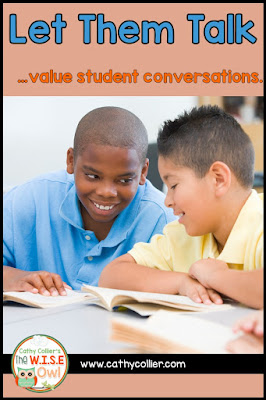One of the best ways to let children demonstrate their understanding in the content areas is to let them talk. Of course, controlling the talking is the secret they don’t have to know. Here are a few conversations your students can have that will let you know just how much they know.
Good Noise
Years ago I had a teacher assistant who would complain every day about the noise in the room. I would constantly tell her, “They are 5. It won’t be perfectly quiet for long.” I’d also say, “They need to talk to communicate their thoughts.” I kept trying to tell her there was a difference between noise and good noise.
Turn and Talk Better
 We all do it, but do you know how valuable it truly is. Make sure there is procedure for talking. Make rules.
We all do it, but do you know how valuable it truly is. Make sure there is procedure for talking. Make rules.
1. Get a partner. Make sure they know WHO they should be talking to.
2. Make sure they know what to talk about. Set a purpose.
3. Make it mandatory that both partner’s talk. Give roles: the talker and the listener. Each student gets a role on a popsicle stick. They rotate holding the signs to share the talk. You can also use the roles to have the students share their discussion with the class.
4. Make them justify. Hold the partners accountable for the “because…” part of the statement. They can’t just give an opinion or a fact, they have to back it up.
 Oral Projects
Oral Projects
Students love talking…so letting them choose what to talk about can help you focus their attention to details. One year, I had a monthly family project. In the middle of the month, I sent home a template due at the end of the month to be displayed for the following month. For example, half way through September I sent home a pumpkin for the students to decorate. It was due the end of the month, to be displayed outside our door for the whole next month. We spent the day they were due letting the students describe their project.
Let’s talk Social Studies and Science
A great way to get students talking is to link the discussion to a social studies or science standard.
Magnets –
According to Virginia Standards of Learning, our kindergarten students needed to understand the laws of attract and repel. It can be a tricky concept for 5-year-olds to express. After magnet play with several types of magnets, including a brief explanation of North and South Poles attracting and repelling, students are put into pairs with “sandwich boards” made of red and blue construction paper with “N” and “S.” They need to have a conversation with each other to determine something that would help them be “attracted” to each other. They also need to determine something that would make them “repel” from each other. They share with the class the things that would attract (donuts, candy, ice cream) and those that would repel (bees, snakes, spiders).Reuse Something –
Our kindergarten students also need to learn about natural resources to reuse, reduce, and recycle. We always have a “reuse” project due at the end of the unit. Students need to create something from something else that would typically be thrown away. When they return their projects to the class, they need to tell the students what they “reused” and made into something new.
This student reused paper plates, a paper towel roll, an old CD (as the base) to create the game.





No comments
Post a Comment